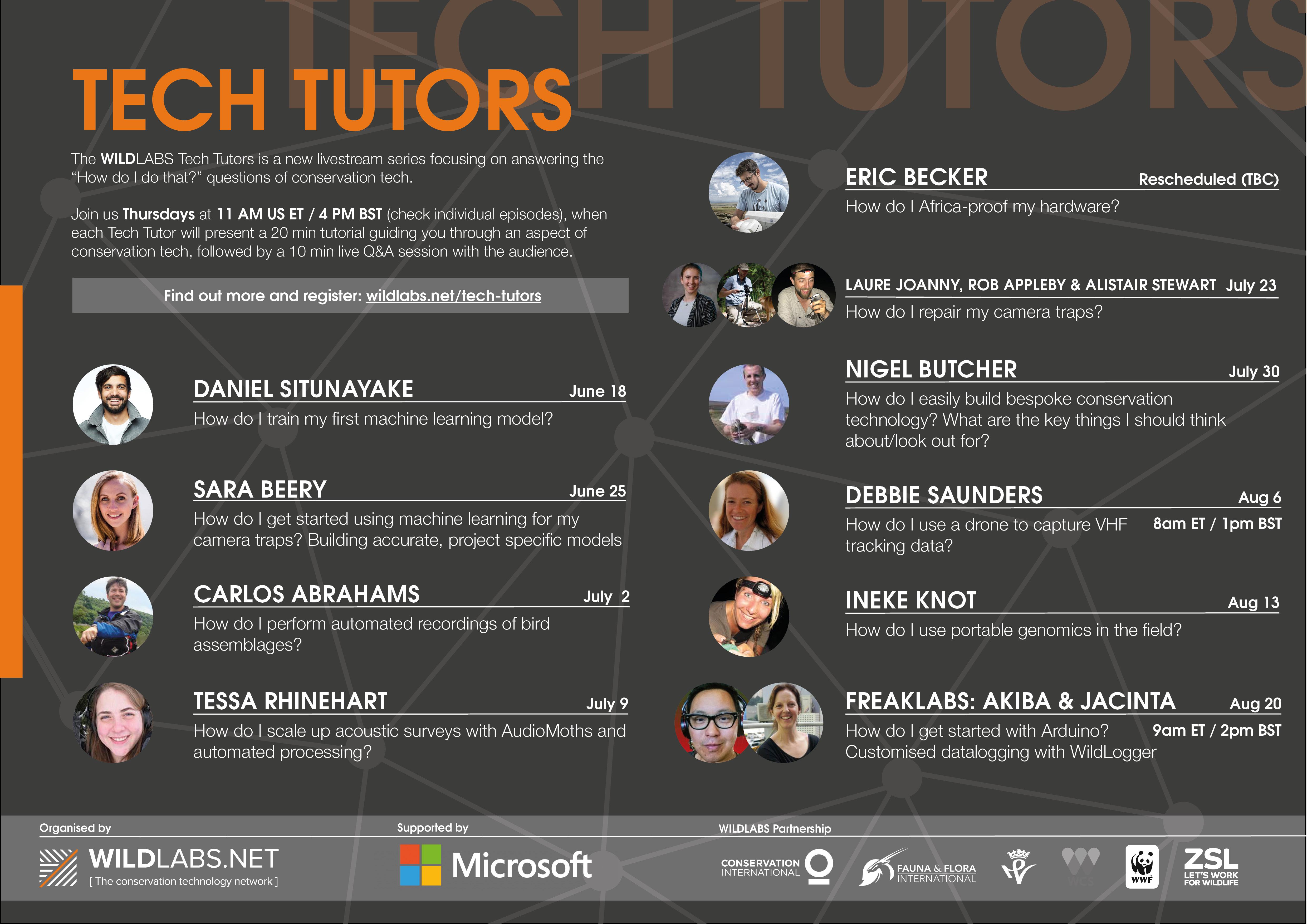About the Series
Introducing the WILDLABS Tech Tutors, our new series that focuses on answering the "how do I do that?" questions of conservation tech. Launched with the support of Microsoft AI for Earth, this series will give you the bite-sized, easy-to-understand building blocks you'll need to try new conservation technology, enhance your research, or DIY a project for the first time.
Taking place every Thursday, each Tech Tutor will present a 20 minute tutorial guiding you through an aspect of conservation tech, followed by a 10 minute live Q&A session with the audience.
For participants, the outcome will be an increased sense of confidence in their technological skills, the ability to actively build off of the skills discussed in these tutorials, and an opportunity to learn and collaborate with other members of the WILDLABS community. Our goal is to customize these tutorials to fit the needs of the community and address your needs, so let us know what you want to see in this season and beyond.
Can't make it? You can find every tutorial after it airs on our Youtube channel.
Catch up on the chat and shared resources from the session in our collaborative notes here.
Meet Your Tutor: Debbie Saunders, Conservation Ecologist & Wildlife Drones CEO
As a Conservation Ecologist, Dr. Debbie Saunders has been studying and protecting critically endangered Swift Parrots for many years within their wintering habitats. However, like many other small animals that move, their movements have largely remained a mystery given the immense challenges of tracking tiny, very high frequency (VHF) radio-tags over broad landscapes.
Frustrated by the limitations of manual radio-tracking, Debbie has now developed a highly mobile and flexible radio-tracking system that can be attached to a drone platform to track multiple animals simultaneously and search large areas efficiently. She will share insights on the capabilities of this unique technology, as well as examples of how it has been applied by governments, NGOs, environmental consultants, and zoos to track a range of different species across a diverse array of landscapes.
Connect with Debbie on Wildlife Drones' website and Twitter.
We asked Debbie...
What will I learn in this episode?
How you can use drones to radio-track up to 40 animals simultaneously. This includes an understanding of new drone capabilities, the latest radio-tracking sensor technology, and the methods used to apply this technology in the field. You'll also learn about the things you need to consider when undertaking a drone radio-tracking project, or any wildlife drone-related application.
How can I learn more about this subject?
Attend Tech Tutors, to start with! For radio-tracking experience, find a local project tracking wildlife and see if you can volunteer and get experience in what it takes to track animals. Find a local group using drones for innovation/good and join them. Jump online and start searching and following groups and people who inspire you!
The use of drones in wildlife research and conservation is increasing, and there are a corresponding number of research articles published online in open source journals with information on different ideas and applications. You can also follow articles on #dronesforgood, #techforgood, #innovation, and some great NGOs and start-ups trialling new technology to hear about new ideas and inspiration.
If I want to take the next step using this technology, where should I start?
Get in touch! Get a drone and a pilot, or borrow one! We’re always happy to talk to people about their project ideas and help by providing information on all the different aspects you need to consider to get a project off the ground.
What advice do you have for a complete beginner in this subject?
Clearly understand the problem you are trying to solve, since you will then be able to find the solution that best suits your needs.
Learn more about our Tech Tutors

Visit the series page on WILDLABS to find the full list of WILDLABS Tech Tutors.


Add the first post in this thread.